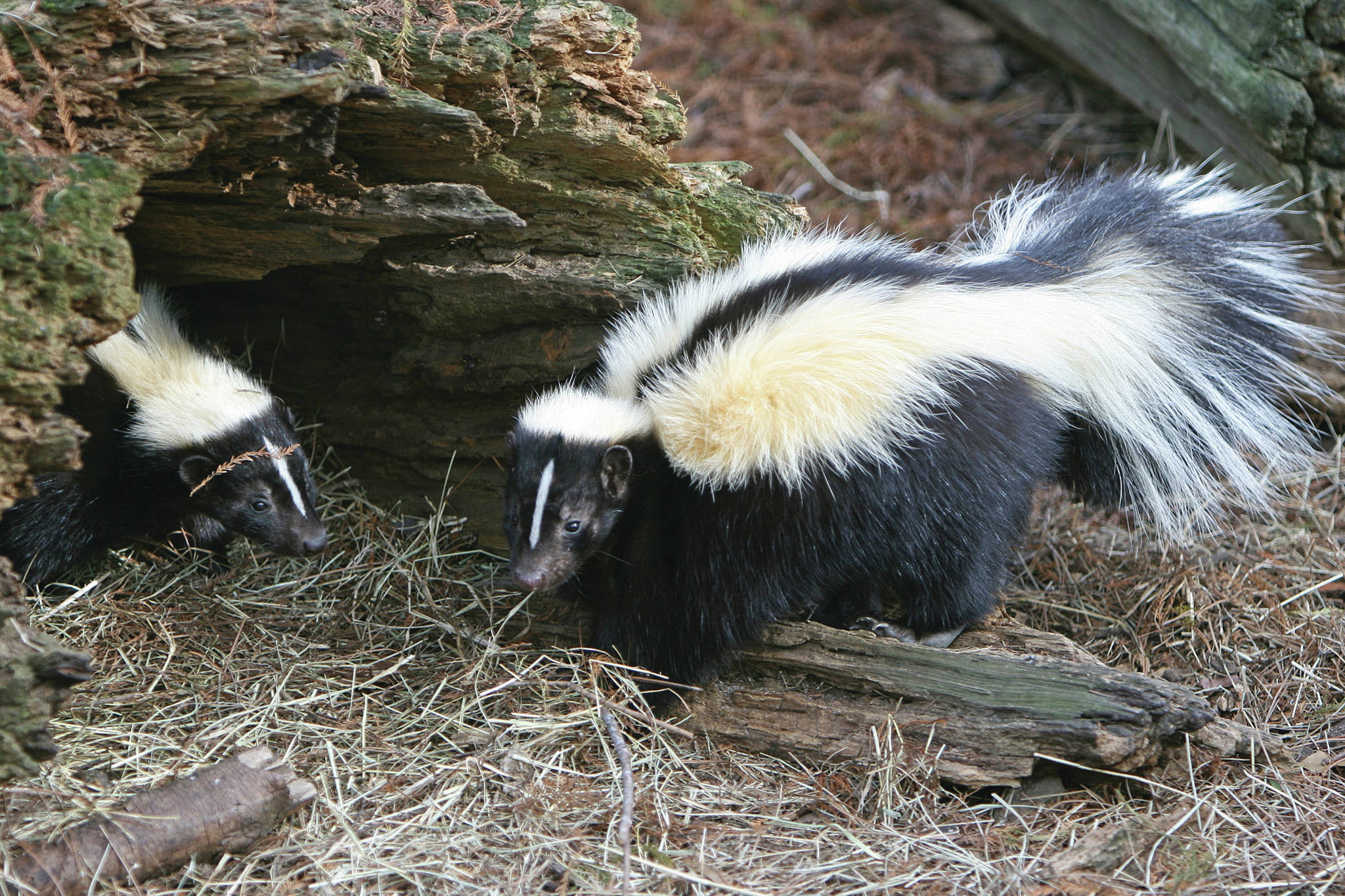Animals defend themselves from attack in many ways.
A few do this by emitting clouds of stuff that is repellent or obscuring (or both). For instance, humans may carry pepper spray to deter a (rare) bear attack (or, especially in a city, another human). The cloud of noxious spray creates strong burning sensations in eyes, nose and mouth, and makes eyes flood with tears.
Other kinds of animals make and carry their own noxious spray. Skunks are a good example. North American spotted skunks are currently classified in four species. Their predators include the wild cats, dogs and coyotes, badgers, owls and humans. When feeling threatened and unable to run away, they first stomp their feet; the next step in defiance is their famous handstand — standing on the forelegs, with tail elevated, and back toward the potential attacker, they show off the black and white warning coloration. If the threat continues, the skunk may squirt out its spray from two glands near the anus. It can do this from the handstand but also may drop down to all fours, curl around so that both head and rear end are pointed at the attacker. The oily spray contains sulfur-based organic compounds (thiols or mercaptans) that stink and sting. Each squirt may be fairly accurate at short range, but then the droplets spread around in air currents and can be effective in a wider area.
[Birds of a different feather can hunt together]
The striped skunk is native across North America. Its defensive spray is similar to that of spotted skunks, but apparently this species does not do handstands before spraying. After foot-stomping, it just turns around and lets fly in the direction of the threat.
Bombardier beetles of many species occur around the world (except Antarctica). They are famous shooters of noxious spray; some species can even swivel the openings of the jets toward the potential attacker. The chemistry of this spray is remarkably complex. Two glands in the beetle’s abdomen contain hydroquinones and hydrogen peroxide; the glands open into a chamber where the two compounds interact (making benzoquinones). That chemical reaction heats the mixture to almost the boiling point of water and produces a vapor that, under pressure, powers the vigorous ejection of noxious liquid. The spray can kill an insect, such as an attacking ant, and irritates the eyes and respiratory system of vertebrates.
Octopuses, cuttlefish and squid store “ink” in a sac that opens into the rectum, where it is, in some cases, mixed with mucus. When alarmed, these critters can emit a dense cloud of ink that is carried on a jet of water; the ink hides them from predators and potentially allows them to scoot away to safety. The ink has many components, apparently, including melanin, free amino acids and metals. In some cases, ejected ink clouds contain extra mucus, and the combined substance takes the form of another octopus or squid, deluding the attacking predator. The ink may also be more than a smoke-screen; it may contain irritating chemicals too.
Large marine shell-less snails called sea hares also emit clouds of ink. The color of this ink depends on the kind of algae the sea hare has been eating: it can be red, purple or white. The ink acts as a smoke-screen against predatory fish, crabs and spiny lobsters. It also contains toxins that deter feeding behavior of the predator — not only is it apparently unpalatable, it can block and thus de-activate the would-be predator’s sensory system.
Not long ago, a tiny shark captured in the Gulf of Mexico turned out to be a new species, known by just this single specimen. It is related to a similar species that is also known from one specimen, taken from the deep sea off the coast of Chile. These are called pocket sharks, for the unusual pockets behind the pectoral fins. The pockets are glands that produce a bioluminescent fluid. There is also another small shark, in the south Atlantic, called the taillight shark; it produces clouds of bioluminescent fluid from a gland on its abdomen. Apparently the functions of these clouds of glowing fluid are not known — the clouds of light might somehow be used in capturing prey or in escaping from predators.
Humans use clouds as defense too: verbal clouds! When a speaker is challenged by a listener, it is not uncommon for the speaker to emit a spate of words that are only marginally relevant to the challenging question, the words circling round and round a concrete answer. The verbal cloud often dulls the senses and distracts (and frustrates) a listener, hiding an uncomfortable truth or maybe hiding the ignorance of the speaker. I’m sure we can all think of situations in which we have endured these obfuscations!
• Mary F. Willson is a retired professor of ecology. “On The Trails” is a weekly column that appears every Wednesday.

